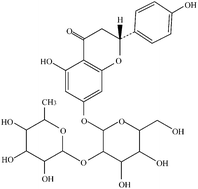Naringin protects against anoxia/reoxygenation-induced apoptosis in H9c2 cells via the Nrf2 signaling pathway†
Abstract
Naringin (Nar) is a major and active flavanone glycoside derivative of several citrus species. The antioxidant properties of Nar have an important function in its cardioprotective effects in various models. However, the effects of Nar on Nrf2 activation and the expression of its downstream genes in myocardial cells are yet to be elucidated. This study was designed to investigate the protective effects of Nar against anoxia/reoxygenation (A/R)-induced injury in H9c2 cells and determine its effects on the activity of Nrf2 and the expression of phase II antioxidant enzymes. H9c2 cells were pretreated with Nar for 6 h before exposure to A/R. A/R treatment severely injured the H9c2 cells, which was accompanied by apoptosis. Nar also suppressed the A/R-induced mitochondrial membrane depolarization and caspase-3 activation. Nar pretreatment significantly reduced the apoptotic rate by enhancing the endogenous anti-oxidative activity of superoxide dismutase, glutathione peroxidase, and catalase, thereby inhibiting intracellular reactive oxygen species generation. Moreover, the presence of Nar alone in H9c2 cells increased the nuclear translocation of Nrf2 in a dose- and time-dependent manner, as well as consistently increased the protein levels of heme oxygenase (HO-1) and glutamate cysteine ligase (GCLC). Nar increased the phosphorylation of ERK1/2, PKCδ, and AKT. However, the Nar-mediated Nrf2 activation and cardioprotection were abolished through the genetic silencing of Nrf2 by siRNA and partially inhibited by specific inhibitors of ERK1/2, PKCδ, and AKT. Therefore, Nar provided cardioprotection by inducing the phosphorylation of ERK1/2, PKCδ, and AKT, which subsequently activated Nrf2 and its downstream genes.


 Please wait while we load your content...
Please wait while we load your content...